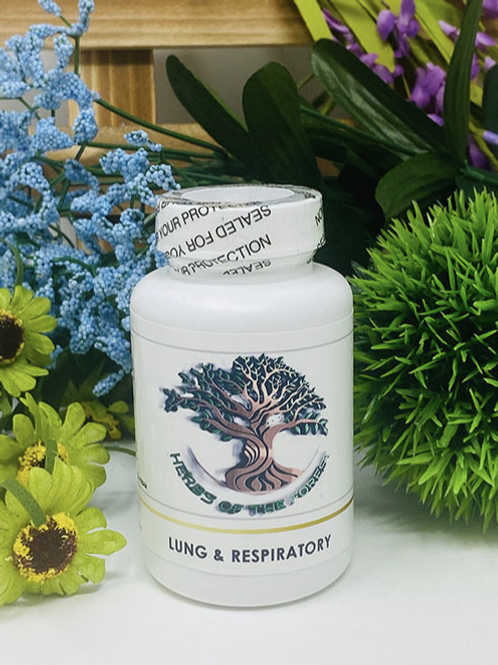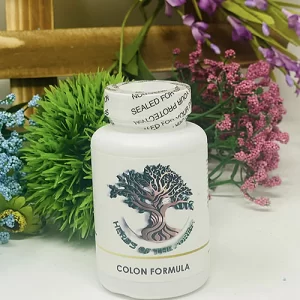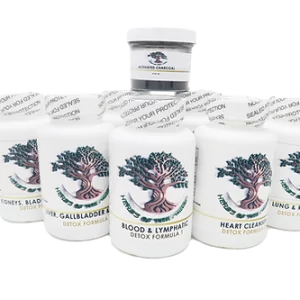Lung and Respiratory
$22.00
Lung and Respiratory
The Lung and Respiratory formula contains herbs that help strengthen the respiratory system by removing mucus and nourishing the lung tissues. This blend of herbs nourishes and repairs lung tissue and helps the body’s natural immune defenses. Contains Eucalyptus, Mullein Leaf and other herbs with a specific affinity for the lungs. In addition, it cleanses the respiratory tract and helps support clear and comfortable breathing. A uncompromised respiratory system is a prerequisite for optimal health.
Benefits:
- Helps maintain clean airways and lungs*
- Assists with boosting your body’s natural defenses, especially in your lung tissue*
- Helps maintain normal breathing*
How It Works:
The respiratory system is a biological system consisting of specific organs and structures used for gas exchange in animals. The anatomy and physiology that make this happen varies greatly, depending on the size of the organism, the environment in which it lives and its evolutionary history. In land animals the respiratory surface is internalized as linings of the lungs.
Gas exchange in the lungs occurs in millions of small air sacs called alveoli. The microscopic air sacs have a very rich blood supply, thus bringing the air into close contact with the blood. These air sacs communicate with the external environment via a system of airways, or hollow tubes, of which the largest is the trachea. The trachea branches in the middle of the chest into the two main bronchi. Bronchi enter the lungs where they branch into progressively narrower secondary and tertiary bronchi that branch into numerous smaller tubes, the bronchioles. It is the bronchioles, or parabronchi that generally open into the microscopic alveoli in mammals. Air has to be pumped from the environment into the alveoli or atria by the process of breathing which involves the muscles of respiration.
Altitude’s impact on the respiratory system
The kidneys measure the oxygen content (mmol O2/liter blood, rather than the partial pressure of O2) of the arterial blood. When the oxygen content of the blood is low, as at high altitude, the oxygen-sensitive kidney cells secrete erythropoietin into the blood. This hormone stimulates the red bone marrow to increase its rate of red cell production. Which leads to an increase in the hematocrit of the blood and a consequent increase in its oxygen carrying capacity (due to the now high hemoglobin content of the blood). In other words, at the same arterial partial pressure of O2, a person with a high hematocrit carries more oxygen per liter of blood than a person with a lower hematocrit does. High altitude dwellers therefore have higher hematocrits than sea-level residents. This explains why people training at high altitudes increases endurance
Involuntary defenses
Irritation of nerve endings within the nasal passages or airways, can induce a cough reflex and sneezing. These responses cause air to be expelled forcefully from the trachea or nose, respectively. Irritants caught in the mucus which lines the respiratory tract are expelled to the mouth where they can be swallowed. Coughing contracts the muscles in the airway walls narrowing the trachea by pulling the ends of the cartilage plates together. By increasing the expired airflow rate to dislodge and remove any irritant particle or mucus.
Contributions to whole body functions
Lung vessels contain a fibrinolytic system that dissolves clots that may have arrived in the pulmonary circulation by embolism. This is often from the deep veins in the legs. They also release a variety of substances that enter the arterial blood, and they remove other substances from the venous blood that reach them via the pulmonary artery. Some prostaglandins are removed from the circulation, while others are synthesized in the lungs and released into the blood when lung tissue is stretched.
Disorders of the respiratory system can be classified into several general groups:
- Airway obstructive conditions (e.g., emphysema, bronchitis, asthma)
- Pulmonary restrictive conditions (e.g., fibrosis, sarcoidosis, alveolar damage, pleural effusion)
- Vascular diseases (e.g., pulmonary edema, pulmonary embolism, pulmonary hypertension)
- Infectious, environmental and other “diseases” (e.g., pneumonia, tuberculosis, asbestosis, particulate pollutants)
- Primary cancers (e.g. bronchial carcinoma, mesothelioma)
- Secondary cancers (e.g. cancers that originated elsewhere in the body, but have seeded themselves in the lungs)
- Insufficient surfactant (e.g. respiratory distress syndromein pre-term babies).
Fun Fact
Horses are obligate nasal breathers which means that they are different from many other mammals. Which means they do not have the option of breathing through their mouths and must take in air through their noses.
Function: Blood and Lymphatic formula contains herbs traditionally used to rebuild and purify the blood and lymphatic fluid of toxic wastes. The herbs in this formula are well known for removing toxins from the blood and lymphatic fluid. Good clean blood is a prerequisite for optimum health.
Ingredients: Mullein Leaf, Fenugreek,Irish Moss, Eucalyptus, Comfrey, Licorice Root, Marshmallow, Cayenne, Boneset, Horehound, Elecampane,Slippery Elm Bark, Lungwort Blackberry, Coltsfoot,Yerba Santa, Wild Cherry Bark,Pleurisy, Thyme, Peppermint, Blood Root, Lungmoss, White Pine Bark and Goldenseal
Lung and Respiratory
$22.00
Related products
-
- Acne, Adrenal Problems, Aids, Alcoholism, Allergies, Alzheimer's disease, Anemia, Anorexia Nervosa, Anxiety, Arteriosclerosis, Arthritis, Asthma, Attention Deficit Disorder, Autism, Bed- Wetting, Blood Disorders, Bronchitis, Bulimia, Bursitis, Calculi, Cancer, Candida, Canker Sores, Carpel Tunnel Syndrome, Celiac Disease, Cell Phone Radiation, Cellulite, Cirrhosis of the Liver, Common Cold, Constipation, Cough, Depression, Dermatitis, Diabetes, Drug Addiction, Eclampsia, Eczema, Endometriosis, Epilepsy, Epstein-Barr Syndrome, Eye Problems, Fatigue, Fever, Fibroid Tumors, Fibromyalgia Syndrome, Food Poisoning, Frigidity
Men’s Full Body Detox
- $149.95
- Add to cart





